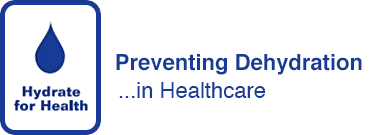The Water-Drop
The Problem
Dehydration is probably the single biggest issue in healthcare. Huge levels of hospital admissions and increased length of stay are a direct result of dehydration. Urinary infections account for over 170,000 admissions and over 1.3 million bed days each year. Falls, constipation, intravenous drips, acute kidney injury (up to 40,000 deaths p.a), blocked catheters, cellulitis and many other issues are often a direct result of dehydration. Not to mention many deaths which are regularly headline news.
Often the CAUSE of dehydration is not lack of fluid but simply the LACK OF EASY, INDEPENDENT ACCESS to drinks. If a person cannot easily reach/lift/hold a drink they will need assistance. Around 20% of hospital patients at any single moment are unable to access fluids without help, approximately 40,000 people per day. Around 3 million vulnerable people in the community and care homes have the same inability to drink without assistance.
The Solution
The Water-Drop is an innovative drinking system specifically designed for hospital patients, care home residents and vulnerable people in the community.
For simplicity – picture an intravenous drip system that is used orally.
The Water-Drop is a simple, low-cost, single patient use, disposable product which fits in with the way the NHS and care homes work at an operational level. The need for such a system is clear and the ongoing headline reports about deaths due to dehydration in hospitals and care homes show how this solution is sorely needed. A quick Google of ‘dehydration deaths in hospitals / care homes’ will show the issue starkly.

The benefits
- Patient experience – improving dignity and independence. Preventing the many health risks from being dehydrated
- Efficiencies on the ward – releasing time to care through knowing patients are now able to help themselves, reduced spillage, reduced need for drugs and huge savings of time and money by preventing unnecessary drip usage
- Bottom line cost reductions at scale. The potential savings run into the £millions (and maybe £billions) through prevented admissions, reduced lengths of stay, reduced drip use, and other reductions due to the prevention dehydration. One unnecessary drip prevention will save the NHS around £1000 through reductions in length of stay, staff time, risk of infection – and up to 50% of all drips should not really happen and are totally avoidable. The potential is phenomenal
- 70% reduction in plastic & packaging use through preventing avoidable drip use
- Substantially reduced hospital admissions from care homes and the wider community
The potential impact from preventing unnecessary intravenous drip use:
At least 50% of all drips set up for rehydration are avoidable.
The total true cost to the NHS of one preventable intravenous drip is around £1000. This claim obviously needs to be justified:
- If a patient has gone downhill to the point of needing a drip to rehydrate then there is a very clear increase in length of stay associated with this deterioration. At least one day and more likely considerably longer. £500 per day.
- The number of people and processes involved in setting up just one drip is considerable: It has to be prescribed by a doctor/prescribing professional; the supply chain has to be activated to get all of the various bits and pieces to the bed; a drip stand and drip pump have to be found; a qualified member of staff has to be found to set the system up; monitoring of the patient has to increase; the fluid bag has to be changed at regular intervals. Cost of these processes £50-100 minimum, per drip.
- There is now a MASSIVE increase in the risks of infection for this patient. Cost of an infection if this happens? – Substantial.
- There is also a dramatic deterioration in patient experience as a result of this PREVENTABLE occurrence.

Winners of The Queen's Award for Enterprise Innovation 2013

